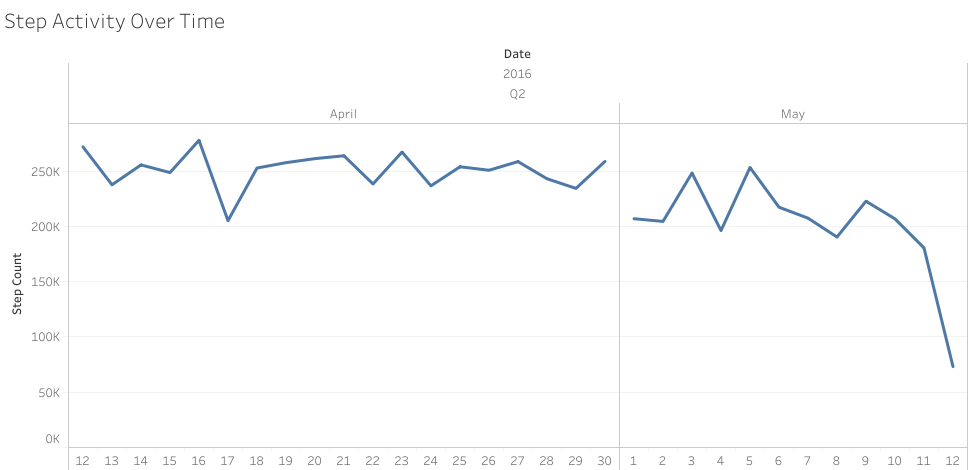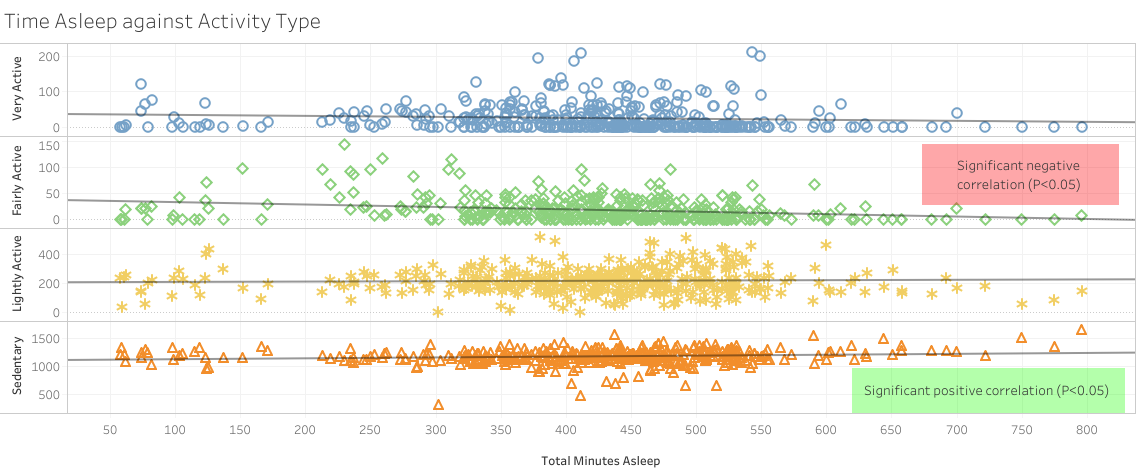My Report on
Bellabeat
This article contains information on the background and purpose of the case study
as well as the the problem statement and information on the data
finally, I deliver trends, relationships and give my recomendations.
I welcome feedback and comments. I sincerely hope you enjoy it.
About Bellabeat
Business Model:
- Primary offering: A tech-driven wellness company for women
- Product: health-focused smart products
- Customer types: Women only (subscribed members and consumers)
- Revenue model: products are sold through online retailers and company websites.
- Marketing: radio, billboards, television and digital marketing (main focus)
- Value: a one-of-a-kind health and wellness tracker created for women by women.
Product Background:
- Bellabeat app: helps users better understand their current habits and make health decisions.
- Leaf: wearable wellness tracker that tracks activity, sleep and stress.
- Time: wellness watch that provides insights into your daily wellness.
- Spring: a water bottle that tracks hydration levels.
- Bellabeat membership: a subscription-based membership program for users.
Scenario
Urška Sršen, the co-founder and Chief Creative Officer of Bellabeat - a high-tech manufacturer of health-focused products for women - believes analysing the data collected by their products can drive company growth. As a junior data analyst working in the marketing analyst team, I focus on one product offering and analyse smart device data to understand how customers use the product. These insights will help guide the marketing strategy for the company.
Purpose
This case study aims to discover insights that paint a clearer picture of how consumers interact with non-Bellabeat products. Also, the insights gained are to be applied to Bellabeat’s Leaf to inform decision-making at an executive level on the future marketing strategy of the company.
Characters and Goals
| Stakeholders | Expectations | Project/Business Goals |
|---|---|---|
| Sando Mur | Compelling, relevant and straightforward insights to inform data-driven marketing decisions | Implementing strategic initiatives to promote business growth |
| Urška Sršen | Evidence to back up her theory. | High-level recommendations for how insights discovered can inform Bellabeat marketing strategy |
| Bellabeat Marketing analytics team | Uncovering consumer trends related to Bellabeat product usage. | Produce data-driven and actionable results to inform business decision making |
Scope of Work
The scope of work for the case study can be found here.
Problem Statement
Currently, Bellabeat is a small company, but it can become a significant player in the global smart device market. One of the co-founder’s and Chief Creative Officer believes the key to Bellabeat fulfilling its potential lies in analysing smart device fitness data. Understanding how consumers use non-Bellabeat smart devices could unlock new growth opportunities if leadership can apply those insights to Bellabeat smart devices.
The Data Source
Data location
The data used in this case study is located here, CC0: Public Domain, dataset made available through Mobius Kaggle profile.
Data organisation
Respondents generated these datasets to a distributed survey via Amazon Mechanical Turk between 03/12/2016 to 05/12/2016. Also, the dataset is a collection of 18 .csv files in a long data format containing personal tracker data, including minute-level output for physical activity (such as daily step and minute-level output for physical activity), heart rate, and sleep monitoring.
Data quality
Data quality was assessed using the ROCCC criteria and determining the credibility and level of Bias of the data. ROCCC is an acronym that stands for reliable, original, comprehensive, current and cited. The results of the assessment are as follows:
- Reliable: Initial exploration of the data revealed the following reliability issues:
- The data sample is only 33 individuals, which makes this sample size too small for proper analysis.
- dailyCalories_merged.csv, dailyIntensities_merged.csv, and dailySteps_merged.csv have repeated information all included in dailyActivity_merged.csv.
- The data was collected for two months which is too small to base for a proper analysis.
- There is no demographic data like gender, sex, age, location to help improve the richness of the analysis.
- Original: Data is from the personal fitness tracker from thirty-three Fitbit users. It is original.
- Comprehensive: Metadata is missing for most of the data, which made understanding and interpretation hard.
- Current: The data is not current. It is from 2016, and a lot could have changed in 5 years.
- Cited: The data is first-party data from the Mobius Kaggle page.
Data ethics
- Licensing:The data has been made available by Mobius.
- Privacy: The data is anonymised. There are no names or addresses that can link the data to the user.
- Security: The data is on Kaggle and protected by their privacy policy
- Accessibility: Under the license, the data is open and accessible.
data integrity
The majority of the data is complete, accurate and consistent with minor human errors.
data relevance
The data contains information relevant to accomplishing the business task.
Cleaning Process
After downloading and storing the data locally, relevant files were loaded into Azure data studio and analysed. SQL was used to prepare, process and analyse the data. Only nine were used from the 18 CSV files in the data set, along with temporary tables created to help with analysis. The nine CSV files were imported as tables, and they are as follows:
- Activity.sql
- Heartrate.sql
- hourlyCalories.sql
- hourlyIntensities.sql
- hourlySteps.sql
- Sleep.sql
- Steps.sql
- Weight.sql
- MET_dat.sql
From the three temp tables made, two are a result of joining some of the tables listed earlier. They include:
- #daily_data.sql: a result of joining activity.sql and sleep.sql on Id, date and weekday.
- #hourlyData.sql: a result of joining hourlyCalories.sql, hourlyIntensities.sql and hourlySteps.sql on Id, date and time of day.
- #stepRanking.sql: a created from steps.sql to classify users into different groups based on their average number of steps taken during the data collection period. Steps between 0 and 5999 have a low count, while those between 6000 and 10999 have a medium count and anything greater has a high count.
Once the analysis was complete, cleaned tables were exported as excel files and uploaded to tableau desktop for visualisation. Data cleaning, transformation and visualisation changes are logged in this change log
Data Analysis
The full code use for analysing the data can be found on my GitHub
Visualisation
All dashboards developed for this project can be found on my Tableau profile
Discoveries and surprises
- Out of the 33 users in total, only eight users opted to collect their weight data, and based on their BMI; they were overweight.
- The majority of the users involved have steps counts that can be described as medium.
- The majority of the users have a normal resting heart rate ( 50bpm - 100bpm), mainly around the 60bpm to 70pm range
-
Users are either active or passive, with the majority being passive.

Trends and relationships
-
User activity declined over time.

-
The more time users spent asleep, the less active they were during the day.

-
Users were more active on weekends.

- Users were more active mid-day on weekends and in the evenings mid-week.
-
Being more intense in their workout and having higher step counts resulted in burning more calories.


Conclusion
As stated earlier, this case study aims to discover insights that paint a clearer picture of how consumers interact with non-Bellabeat products. Also, the insights gained are to be applied to
Bellabeat’s Leaf to inform decision-making at an executive level on the future marketing strategy of the company.
Bellabeat Leaf is a wearable wellness tractor that tracks activity, sleep and stress. Therefore, a successful marketing strategy has to leverage the insights that speak to the product offering. In line with this objective,
three areas of concentration were identified.
Areas of concentration
- What product offering are users most interested in?
- When are users most active?
- How consistent are users?
Recommendations
A focus on sleep
I examined the datasets used for my analysis to determine if all users were using every available tracking option. The table below summarises my results.
| Dataset | Unique users | Days measured |
|---|---|---|
| Weight | 8 | 31 |
| Sleep | 24 | 31 |
| hourlySteps | 33 | 31 |
| hourlyIntensities | 33 | 31 |
| hourlyCalories | 33 | 31 |
| MET | 33 | 31 |
| Activity | 33 | 31 |
| Heartrate | 33 | 31 |
| Steps | 33 | 31 |
Per the table, it’s clear that users are more interested in activity tracking than sleep and weight tracking. However, users are more interested in tracking their sleep patterns than their weight. In line with this revelation, my recommendation is as follows:
- Since the leaf tracks activity, sleep and stress, it is clear that improving user willingness to track their sleep would be essential to show the value of the products.
- The marketing campaign should focus on the aesthetic, physical and mental benefits of having a healthy sleep pattern as well as an active lifestyle.
- The marketing campaign needs to focus on the comfortability and reliability of the leaf when the user is awake and when they are asleep.
It's go time!
Results of the analysis revealed that there was a general decline in activity after about two and a half weeks. More research needs to be done to determine why that happened, but one possible option is decreased enthusiasm.
Moreover, the analysis also reveals that users were most active on weekends compared to the middle of the week. Regarding the time of day, users were most active in the afternoon’s on weekends, and they were most active in the
evening during the week. Based on these trends my recommendation is as follows:
- Implement triggered reminders based on user-specific activity patterns. One way to accomplish this by leveraging the Bellabeat mobile app. Also, If a user’s activity declines over a specified number of days, they are notified on their watch and their phone through the mobile app. This way, the reminders will remind users to get active when they usually get active and help them regain consistency if they fall off.
- More research needs to be done to determine viability, but this could help motivate users to improve their activity levels. The marketing campaign needs to focus on accountability and community. Maybe provide a platform for users to post their post-workout pictures or videos ans some words to express how they feel.